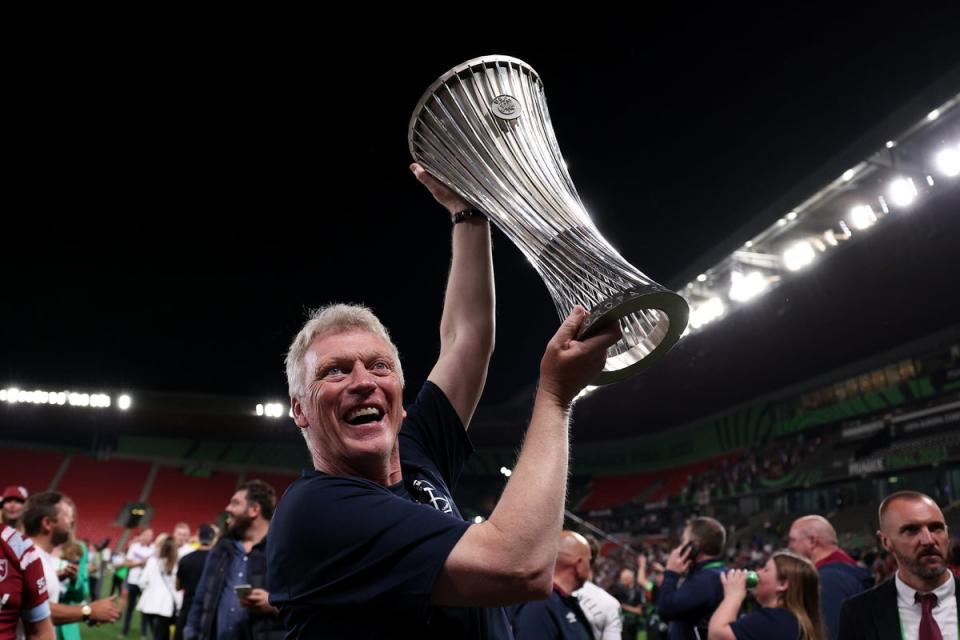Why the adaptable David Moyes is the stabilising force Everton need

David Moyes was in his thirties when first appointed Everton manager. He occupied the position for all of his forties and a few weeks of his fifties. Now he has taken it again in his sixties. Should he finish his newly-signed contract, which lasts until 2027, he will be in charge of Everton a quarter of a century after he first took the post. He will be Everton’s first manager at Bramley-Moore Dock and their last at Goodison Park. His words decorate the outside of Everton’s historic home. It was Moyes who branded them “the people’s club”.
The people have had an increasingly traumatic time in Moyes’ absence. He had been gone for just over 11-and-a-half years, in charge for almost 11-and-a-half before then. There is a stark contrast. Moyes is the ninth manager since Moyes himself, not counting the four old Evertonians who have served as caretaker. Moyes took Everton to nine top-eight finishes, eight of them in the top seven. Everton have not finished seventh since 2017 or eighth since 2019. He inherited a relegation scrap in 2002, but there were none in his last seven years in charge. Now they are annual issues.

Over 11 years, Moyes had a net spend of around £30m. It averaged out at around £2.8m per season. While Everton have made a transfer-market profit over the last five years, it was an unwanted and enforced correction after the wild overspending of the first half of Farhad Moshiri’s ownership. Everton have ended up with the worst of both worlds, failing Financial Fair Play while the team was weakened. And if there are other causes, including building Bramley-Moore Dock and the loss of Alisher Usmanov’s sponsorship and financial input, if the one element of Everton that is better now than in 2013 is the new stadium that long looked a necessity, in other respects Moyes returns to a club in a far worse position than he left it.
Many a manager presents themselves as a custodian of their club. Moyes actually was. Pound-for-pound, he did one of the great managerial jobs in Premier League history. When Everton’s fans still sing “Sixty grand, sixty grand, Seamus Coleman”, they are highlighting Moyes’ capacity to make a little money go a long way. Coleman was one of Everton’s caretaker managers on Thursday, hours after Sean Dyche’s departure. The other was Leighton Baines, another great Moyes buy, part of his relentless research as he put the hours in; he once said he scouted Joleon Lescott 24 times before buying him, but recouped the third highest fee then ever paid for a defender when selling him.

“The football club is in a position where it definitely wants some stability,” Baines said after beating Peterborough. “We have been through a lot.” Few have ever promised stability like Moyes. It isn’t a glamorous promise but if ambitious new owners can sometimes be seduced by glamour, The Friedkin Group may be scared by lessons learnt at Roma. Now their flagship clubs have been entrusted to Claudio Ranieri, a manager since 1986, and Moyes, appointed by Preston in 1998. Moyes is charged with being both Everton’s Ranieri, the steady old hand, and their Daniele de Rossi, the man with the distinguished past at the club. But not, they hope, their Jose Mourinho.
Everton can wonder if the last few years would have been different had Moshiri not found Carlo Ancelotti irresistible in 2019, when the alternative was Moyes. And if the Italian’s first year was enjoyable, it may have been unaffordable. Perhaps the mess of Moshiri’s Everton would have engulfed even Moyes. Certainly, though, West Ham, who instead went for the Scot a few weeks later, had a greater reward for their apparently pragmatic choice. Moyes took his tally of top-nine Premier League finishes to 12, won the trophy that eluded him at Everton, in the Europa Conference League, and demonstrated that he is no anachronism.

Comparisons may be drawn with Dyche, another experienced British manager who sought to harness Everton’s spirit and bring a defensive resolve, but they are misplaced. Moyes has never been as one-dimensional; give Dyche the budget and it is impossible to imagine him signing a player in Lucas Paqueta’s mould. Moyes isn’t one of football’s more famous philosophers, but a solid base isn’t the limit of his stylistic ambitions.
And at his best, he can seem timeless. The cliché is to never go back; he actually had more success in his second spell in charge of West Ham than the first. If it will be harder to do likewise at Everton, the siren call of the Z-Cars theme at Goodison proved impossible to resist. He may have had unfinished business. So do they. Too often in the last 11 years, Everton have missed Moyesian values, the grim-faced determination that helped him overachieve over a decade.
He was already Everton’s finest manager of the Premier League era, with a place in their history. Now a relegation battle brings a risk of tarnishing it, but also enhancing it. Stay up and Moyes should go past Howard Kendall and Harry Catterick’s totals of games in charge of Everton. He can take top-flight football to their new stadium. He was the youngest manager in the Premiership, as it was, when first appointed by Everton and is the oldest in the Premier League now. But now, as then, he is the manager Everton need.

